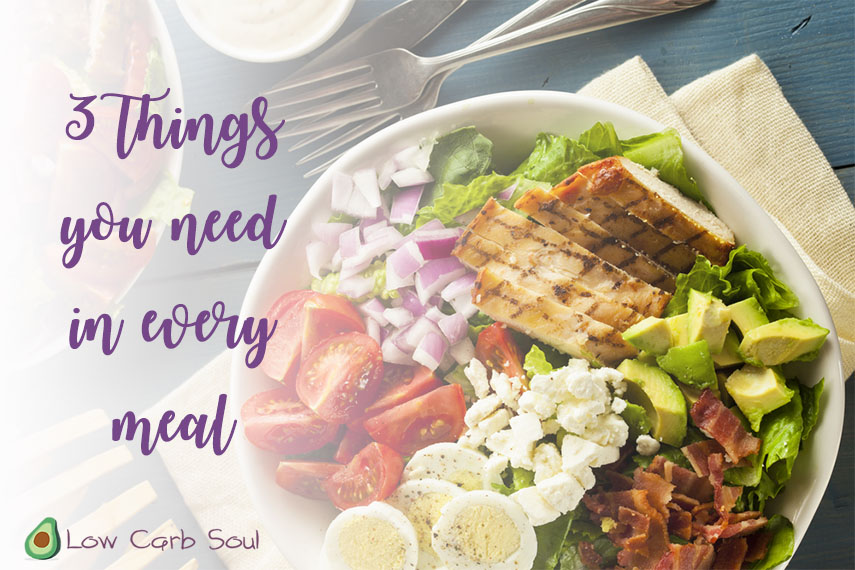The 3 things you need in every meal
Way back when I first became interested in nutrition, I learned something that immediately changed the way I ate, and has informed my diet ever since. I don’t remember exactly where I learned this, but I think it may have been from Frank Lipman, an integrative physician I have been following for many years.
What I learned is this: There are 3 things you should include in every meal. Can you guess what they are? (Hint: carbohydrate is not one of them.)
- Healthy fats
- Protein
- Phytonutrients (plant compounds)
I’ve been eating this way for years — well before I ever went ketogenic — and this is how I approach all of our meals at home. (Okay, my husband does about 75 percent of the cooking at our house, but we both eat this way, although he does eat carbs like rice and oatmeal and bread, and has a particular fondness for donut holes.)
You can easily see what’s missing here: grains, which we’re told should form a large portion of our diet. There’s a prevailing belief in our culture, even among health professionals, that we need grains and starches for energy. We don’t. The body needs glucose for some functions, but it can create whatever glucose it needs from protein.
I see a lot of keto recipes online that have the fats and protein covered, but are sorely lacking in plant compounds. I also see people commenting in keto groups and forums that greens and veggies aren’t necessary. I strongly disagree. Plant foods have a lot of compounds in them — polyphenols and antioxidants — that help keep your cells functioning optimally and protect you from disease. You simply won’t get the same benefits from a vitamin.
Blueberries, for example, help maintain the health of arteries by keeping them flexible, which reduces the risk of cardiovascular disease. Consumption of flavonoids — compounds that also give plants their vibrant colors — has been associated with better cognitive performance in people over the age of 65.
Studies have also found that polyphenols help lower blood pressure, reduce inflammation, prevent the growth of tumor cells, and increase lifespan. Polyphenols also have additional benefits when different compounds are consumed together, which further supports the need to include a variety of plant foods in the diet.
Tips for including more plant foods in your diet
I hear a lot of people say they don’t like vegetables. My response to this is usually twofold: 1) you probably aren’t cooking them properly, and 2) your tastes will change, given time. If you’re used to eating a diet that’s high in sugar and processed foods, you’ve likely trained yourself to favor those foods. The more you distance yourself from those foods and include healthy foods in your diet, the more you’ll actually start to appreciate and even crave healthy, whole foods. Trust me. I used to live on Taco Bell and Kraft mac & cheese, but now I find myself craving kale.
Try these steps for getting more plant compounds into your diet:
- Look for ways to include more plants in the foods you’re already making. Add some baby spinach to your scrambled eggs. Have some pickles or sliced cucumbers with your ham & cheese rollups at lunchtime.
- Start with one or two foods (like the pickles) and try more once you get used to those.
- Drink your greens. You can add a lot of baby spinach to a smoothie without really impacting the flavor. Or try this avocado + spinach smoothie for breakfast.
- Have a handful of blueberries for an afternoon snack.
- Opt for salads, especially when eating out. Most restaurants serve them, and ingredients such as hard-boiled egg, bacon, or salmon allow you to get your fat and protein in.
- Put avocado on everything — it’s a plant and a fat! I use avocado in smoothies, salads, eggs, even blended vegetable soups.
- Serve a side salad with dinner. We’re big fans of the Taylor Farms salad kits, which I get at Target. We rarely have dinner without a salad.
- Don’t overcook your veggies. A lot of us grew up eating boiled, bland veggies. Get yourself a veggie steamer — steamed veggies will taste much lighter and fresher. Steam up some broccoli and top it off with butter, if you eat dairy. Yum.
- Don’t be afraid of salt. You need to replenish your electrolytes when you’re ketogenic. Also, fun fact: approximately 75 percent of the population (myself included) are what’s known as “bitter tasters,” meaning they have an increased sensitivity to bitter flavors. If you find foods like kale or Brussels sprouts too bitter, salt helps.
Are you getting enough veggies in your keto diet? What are your favorite ways to eat them?
Tags In
Karen
Leave a Reply Cancel reply
Categories
- Holistic Health (3)
- Ketogenic diet (4)
- Meal Planning (3)
- Nutrition (1)
- Recipes (2)
- Weight Loss (2)



